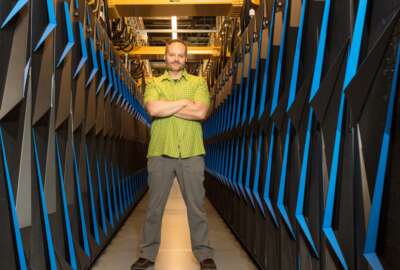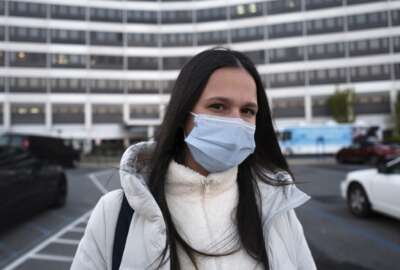
Fighting COVID-19 with supercomputers
A month ago three departments — Energy, Health and Human Services, and Veterans Affairs — established what they call the COVID-19 Insights Partnership. It...
Best listening experience is on Chrome, Firefox or Safari. Subscribe to Federal Drive’s daily audio interviews on Apple Podcasts or PodcastOne.
A month ago three departments — Energy, Health and Human Services, and Veterans Affairs — established what they call the COVID-19 Insights Partnership. It brings together a lot of health data from HHS and VA, and feeds it into Energy’s super computers. With more on what they’re up to, Federal Drive with Tom Temin spoke to Bronson Messer, director of science at the Oak Ridge National Laboratory.
Interview transcript:
Tom Temin: Mr. Messer, good to have you on.
Bronson Messer: Yeah, it’s a pleasure.
Tom Temin: Now tell us about this Insights Partnership. It’s only a month old. What is the status of it so far?
Bronson Messer: First of all, we’re really excited. The ability to be able to access the datasets from HHS and the VA are going to allow sort of analysis that we haven’t been able to be done before on any supercomputer and certainly not on ours. But because they are health-related data, we had to be very careful about how we handle them. But we have lots of controls in place to do that. But we are being somewhat careful in doing that. Nevertheless, by running large-scale and complex analysis on all these data, I think we’re going to be able to gain real insight into either genetic expression of the disease or response, perhaps even guiding other work that goes on on Summit, our large supercomputer, in ways that we hadn’t anticipated before.
Tom Temin: And do you know which data types that you’ll be loading in yet? Or is that still being worked out?
Bronson Messer: I think that’s still being worked out. But it’s certainly true that the modern world of data, we’re talking about data that is in general, multimodal – that is, it can be anything from patient records that have been scanned in at some point to records that are in a database to genetic database information to images. And that’s really one of the challenges of modern data management and handling is how to handle all this multimodal data, and in fact, how to compute on it, how to glean insight from it.
Tom Temin: Because my understanding is that even with all of the data that could be gathered, say from the two departments, HHS and VA, it’s sort of not big enough to have the supercomputer more than loaf along. Am I right on that?
Bronson Messer: It is an impressive machine. We’re currently number 2 on the top 500 List of supercomputers in the world. We’re the nation’s largest supercomputer. Summit is quite big indeed, it has a peak speed of 200 petaflops, which is 200 quadrillion floating point operations per second. For things that are like artificial intelligence and machine learning, it can actually run 16 times faster than that, because you don’t have to keep as many numbers in memory. So it can do 3.3 exaops, if you’re doing sort of machine learning and AI. It has well over 250 petabytes of disk in a single sort of unified file system. It looks like a single drive, like would be on your laptop and you actually write to Summit’s file system. And it has more than 10 petabytes of memory inside the computer itself, in addition to the memory that are on all the GPUs that are sort of the workhorses when it comes to powering the thing. One of the reasons is that here in Tennessee is that we have abundant power from TVA because the machine itself is about 13 megawatts to keep powered and the cooling takes even more.
Tom Temin: Yeah, you can probably fry an egg on some parts of it when it’s really cooking. And just from an organizational standpoint, how does this partnership work? Is there monthly meetings, weekly meetings? And how are you all meeting since you can’t meet in person?
Bronson Messer: Of course, like everyone else, we’re leveraging teleconferencing software like crazy. We’re sort of at a monthly cadence now with smaller teams meeting much, much more regularly than that, to try to coordinate exactly how we’re going to be able to bring the data in and operate on it.
Tom Temin: But the final hoped-for output is what, insight into the genetic or internal characteristics of the COVID-19 virus?
Bronson Messer: I think we’re kind of looking at a lot of different facets of the disease, that is one. But other things are just patient outcomes, what treatments seem to have worked in a purely empirical sense. We have other projects on the machine already that are looking at tons of various aspects of the virus from doing molecular dynamic simulations of how the virus and that spike protein that everybody’s seen in the, in the artist’s rendition sort of docks with the human cell and how drugs may get in the way of that somehow, as a treatment. We also have other projects that are looking using machine learning and artificial intelligence to how different drugs can be used in combination to attack the virus. But we’re also looking at things like patient outcomes, how the disease spreads, and epidemiological way. One of the great things about Summit is it’s a unique scientific instrument, but it can do a lot of different things. It’s as unique as the Hubble Space Telescope or as the Large Hadron Collider at CERN in Europe. But it is a multi-purpose science machine. It can do a lot of different things.
Tom Temin: We’re speaking with Bronson Messer, he is director of science at the Oak Ridge National Laboratory. And I think you alluded to an earlier consortium formed early in the pandemic, the HPC COVID Consortium, which brings high performance computing assets from several agencies and some other, I guess, academic partners. Tell us a little bit about that. And what has been happening in the month since that was established.
Bronson Messer: Right. So the consortium, as you say, it is a collection of public and private providers of high performance computing and cloud resources. The cadence at which that consortium has – we’ve received proposals and that we’ve awarded allocations on different machines has been a pretty steady drumbeat. We meet now several times a week to form proposals out to different pieces of the consortium. At Oakridge we have almost a dozen of these projects running on Summit sort of all the time. People can go to our website and easily see one of these, how many of these HPC consortium projects are actually running on the machine at any given time? summit, as we’ve already talked about is good at lots of things. But it’s really good at molecular dynamics, and it’s really good at artificial intelligence and machine learning. And that tends to dominate the kind of things that we’re doing, from doing small compound studies for drug design of the proteins that sort of sparkle on the outside of the coronavirus, and the receptor in the human cell that actually gives it ingress into the human cell – a way to gum up those works and make sure that it can’t get in – to doing things like machine learning to try to figure out, can you use different combinations of drugs in a more effective way. If one drug is somewhat effective, and another drug, maybe even isn’t as effective, can they be used in combination to be more effective? And all that is tied up in genetic expression and how patients actually react to those drugs?
Tom Temin: And, of course, we’ve been talking about the data fed into it, but data is no good without applications. And so how are the applications getting written in a way that can use the data to get the question answered that you’re seeking, and also that will make sure that Summit operates efficiently?
Bronson Messer: That’s absolutely right. It’s a combination of the hardware and the software on Summit, really, all the way from the file system, this big, large high-bandwidth, 250 petabyte unified file system that we have, beating data into Summit constantly. But then, of course, the hard part is to marshal the power that’s on each node in the machine as well as being able to coordinate them together. For the most part software on Summit is custom software. The individual groups who actually undertake the research projects have written their own, or are in close contact with the developer teams. One of the hardest things to do has been to really harness the full power of the GPUs, the graphical processing units that form most of the computational horsepower for the machine. To be able to effectively marshal those things is a really big boon to the computational speed. They’re really good at – again, they’re very good at it MD and at AI. And so once you get a code that can actually make use of that, it’s very, very useful. It’s also important to have a complete workflow that allows a human being then to look at the results and be able to glean actual scientific insight from them. And we have lots of folks at the Oak Ridge leadership computing facility who are very, very concerned with making sure that workflow goes all the way from picking the data up off the disk to actually doing the computing to actually getting some insight from the final result.
Tom Temin: And with these two consortium going on and with Summit cranking away here – by the way as Summit a he or a she?
Bronson Messer: You know, I think it’s neutral gender. I always like to ship refer to it as a her. It’s a big beast and sort of is reminiscent of a ship. It covers about the space of two tennis courts. And you – we alluded to earlier how hot it could get dissipating 30 megawatts of power. Because of that whole machine’s liquid-cooled and so there’s lots of huge flanged water pipes in the data center as well. So it’s very reminiscent of being on a ship. So I think you’re almost compelled to do the usual Naval thing and refer to it as a she.
Tom Temin: And have you had some “a ha” moments in these consortia where something has been discovered that people say, wow, that’s something we needed to know?
Bronson Messer: I think we have. One of the researchers local to Oak Ridge, Stan Jacobson, recently a published paper where they made a discovery using genome analysis that the so-called bradykinin system, the system in your body that sort of controls your blood pressure. And it does that by making your blood vessels more or less porous to water. It looks like perhaps that’s the system that’s actually attacked by the virus most effectively. You know, we’ve heard stories about people feeling as if they were drowning. And it looks like that system may be tightly bound, and tied up in the the body’s response to the virus. The explanation I heard was that was very much a eureka moment when he when they looked at the data and said, wow! It’s sort of obvious that this system is the one that’s responsible for that feeling and is really probably responsible for a lot of the, at least outward manifestations of the symptoms of the disease.
Tom Temin: Bronson Messer is director of science at the Oak Ridge National Laboratory. Thanks so much for joining me.
Bronson Messer: My pleasure, thank you very much.
Tom Temin: We’ll post this interview along with a link to more information at www.FederalNewsNetwork.com/FederalDrive. Hear the Federal Drive on demand and on your device. Subscribe at Apple Podcasts or Podcastone.
Copyright © 2025 Federal News Network. All rights reserved. This website is not intended for users located within the European Economic Area.
Tom Temin is host of the Federal Drive and has been providing insight on federal technology and management issues for more than 30 years.
Follow @tteminWFED





